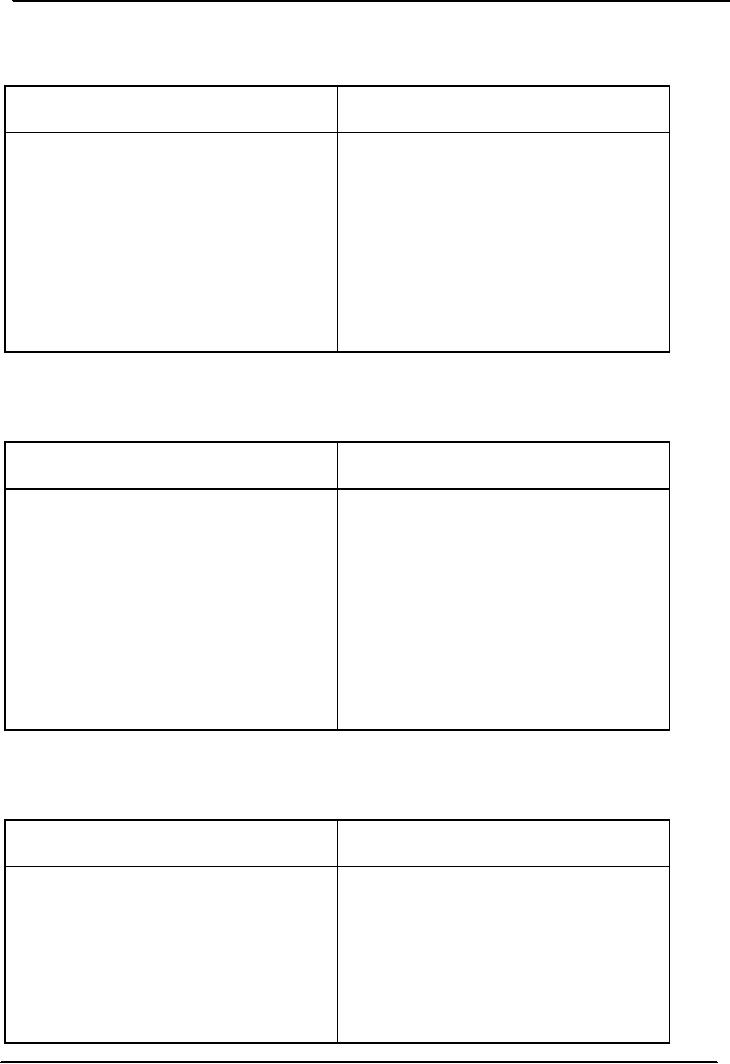 |

Theory
and Practice of Counseling -
PSY632
VU
Lesson
11
COUNSELING
SKILLS
The
counseling relationship is defined as the
quality and strength of the
human connection that
counselors
and
clients share. Listening and
showing understanding skills are
central to building quality
relationships
with
clients. All counseling relationships
consist of two relationships: the
counselor's relationship with the
client
and the client's relationship with the
counselor.
�
All
systems of counseling / therapy employ
various patterns of skills,
known as microskills.
�
Microskills
are observable actions of
counselors & therapists that
appear to effect positive
change
in
the session in which active listening
involves both receiver and
sender.
�
Complex
interaction is broken down
into manageable & learnable
dimensions. Once you
learn
these
skills they can be fitted in a wide
variety of theoretical orientation. When
you learn new
methods
of therapy, you can build them on
these skills and frame them
into a variety of techniques.
Microskills
Different
microskills are described in the
following:
�
Attending
skills
�
Listening
skills: "Basic listening
sequence"
�
Focus
and selective
attention
�
Influencing
skills
�
Confrontation
& challenging
Attending
skills
Attending
skills is a simple phrase
for a complex collection of behaviors
and abilities.
�
Attending
skills are comprised of a
series of complex proficiencies that cut
across the verbal and
nonverbal
domains of communication. It is rare that
people receive the full attention of
their
communication
partner(s). When it does
happen, they are keenly aware
and appreciative of this
fact.
It is rare that people place
full attention on themselves;
hence, it is not surprising
that most
clients,
and perhaps too many
clinicians, are unaware of,
or inattentive to, their own
Meta
communications.
Clients are frequently
unaware of communications that go beyond
the verbal, and
clinicians
may forget to attend to these
nonverbals.
�
Attending
refers to the focused attention
that is placed on the other
person in an interchange
between
two (or more)
people.
�
Without
attending skills, the
establishment of therapeutic rapport is
most likely
difficult,
if
not impossible.
Attending
skills: Nonverbal Communication
Nonverbal
communication is important from two
perspectives:
�
Nonverbal
communication expressed by the client and
picked up by the clinician.
�
Nonverbal
communication used by the clinician for therapeutic
goals.
Attending
nonverbal communication is an excellent
means of gaining a clearer understanding of
clients as it.
It
opens up a major area of
meta-communication:
�
Body
language & movement
�
Paralinguistic
�
Physical
space
�
Timing
48

Theory
and Practice of Counseling -
PSY632
VU
Body
Language & Movement
�
Kinesics
can emerge from any
body part. Some of the most
important body features
observed
involve
head, face, eyes, mouth,
shoulders, arms, hands,
legs, feet, and
torso.
�
Motor
movement observations about all body
parts are important as they
can provide a great
deal
of
information.
�
Motor
movement overall is often further
defined as agitated, fidgety,
unusual, normal, or as
including
tics, tremors, or motor
abnormalities.
�
Autonomic
responses are also often
included, drawing attention to physiological reactions
such as
rate
of breathing, blushing versus paling, or pupil
dilation.
�
All
motor and facial expressions
can be assessed in terms of
their congruence with verbal
content
of
conversation as well as the level of activity or
agitation they may
suggest.
Table
1
Sample
of Possible Interpretations of Common
Kinesics: Eyes
Nonverbal
Expression
Possible
Meaning
Direct
eye contact
Attentiveness
Lack
of contact
Withdrawal
Looking
down/ away
Avoidance,
preoccupation
Fixed
staring
Uptightness,
psychosis
Eye
blinking
Anxiety,
excitement
Squinting
or wrinkled brow
Annoyance,
concern, thoughtfulness
Dilated
pupils
Alarm,
interest
Kinesics
derives additional importance from the
reality that they are commonly used as
substitutes to verbal
communication.
In other words, quite
frequently clients use their
body to respond to a clinician's
question.
Table
2
Sample
of Possible Interpretations of Common
Kinesics: Mouth
Nonverbal
Expression
Possible
Meaning
Smiling
Greeting,
Positive mood, denial
Tight
lips
Stress,
Anger/ hostility, Concentration
Quivering
lips
Sadness,
Anger, Anxiety
Biting/
Chewing of
Anxiety,
Bad habit
lips
Surprise,
Boredom/ fatigue/ yawning
Open
mouth
49

Theory
and Practice of Counseling -
PSY632
VU
Table
3
Sample
of Possible Interpretations of Common
Kinesics: Facial
Expressions
Nonverbal
Expression
Possible
Meaning
Flushed
face
Embarrassment,
Anxiety
Eyes
open wide
Surprise,
Sudden insight
&
mouth opening
Furrowed
brow with
Deep
thought/ concentration
tight
mouth
Irritation/
annoyance, Rejection of
a
therapist response
Table
4
Sample
of Possible Interpretations of Common
Kinesics: Shoulders and
Arms
Nonverbal
Expression
Possible
Meaning
Shrugging
shoulders
Uncertainty
or ambivalence,
indifference
Slouched
shoulders
Sadness,
withdrawal/ shyness
Bad
posture, Self-protection
Folded
arms
Closed
to contact, emotional
distance
Open
gesturing
Openness
to disclosure
Stiff
and/or unmoving
Anger,
Anxiety
Table
5
Sample
of Possible Interpretations of Common
Kinesics: Legs and
Feet
Nonverbal
Expression
Possible
Meaning
Crossing
& uncrossing
Anxiety/
nervousness, Depression
Self-protection
Foot
tapping
Anxiety,
Impatience
Stiff
and/or Controlled
movements
Closed
to contact, Repressed
attitude,
Sore muscles
50

Theory
and Practice of Counseling -
PSY632
VU
Table
6
Sample
of Possible Interpretations of Common
Kinesics: Body Movement
Nonverbal
Expression
Possible
Meaning
Leaning
forward
Attentiveness,
interest
Leaning
away or back
Withdrawal,
Rejection
Relaxation
or comfort
Turned
to the side
Avoidance,
Fear of rejection
Rocking
or repetitive motion
Anxiety,
nervousness,
Bad
habit, Developmental disorder
Habitual
movement (e.g.,
Focused
attention,
tapping,
hair twirling)
Impatience,
Bad habit
Paralinguistics
The
therapist attends to how high or
low the client's volume is
when speaking of various
contents, and
whether
volume or inflection changes depending on
topic. Very high volume
may relate to anger,
whereas
very
low volume may indicate
sadness.
Nonverbal
or metacommnnication aspects related to voice
and speech have great
communication value. A
high-pitched
voice may suggest anxiety; changes in
inflection may direct attention to
particularly emotional
topics.
Counselors
direct their attention to several
aspects of speech, including voice
volume, articulation, pitch,
emphasis,
and rate (VAPER). Speech
fluency is explored with regard to the
intrusion of stuttering or similar
speech
errors, as well as jerky
speech that changes in clarity
and fluency across topics.
For example, sudden
hesitations
in speech may indicate anxiety about a
topic or second thoughts about
self-disclosure. Speech
errors,
such as wrong word choice or
inability to think of the right
word, may suggest anxiety or
resistance.
Rate
of speech refers to the speed
with which the client
communicates. It could theoretically be
evaluated
by
looking at the number of words spoken
per minute. Most concretely,
rate ranges from slow to
fast.
Slower
speech rate helps you
appear less nervous, and
also provides more time to think of what
to say.
Effect
of Gender and Culture
Rate
of speech varies greatly
across cultural groups.
Use
of Pauses and Silence
�
Use
of pauses and silence
enhances your capacity to be a rewarding
listener.
�
The
counselor can pause each
time they stop speaking before responding to
see if they wish to
continue;
�
Good
use of silence also gives
clients more psychological
space to think things through
before
speaking.
Some counselors and clients
find silence threatening; they have to
work on tendencies to
interrupt
too soon.
51

Theory
and Practice of Counseling -
PSY632
VU
Skill
Development Activity 1
�
From
now on, while engaging in
conversations with others begin to
focus on their
nonverbal
expressions
of emotions.
�
'Note
facial features, body
posture, gestures, and other
bodily cues about the person
you are
interacting.
�
Do
not allow the verbal content to
get in the way of your
nonverbal listening.
�
Pay
careful attention to body
language, even if it appears
inconsistent with what is being
said.
�
Begin to
notice if different people have different
ways of expressing the same
message.
Skill
Development Activity 2
�
From
now on, when you
are in a public place with
extra time on your hands,
become a people
watcher.
�
Without
hearing their conversations,
pay attention to how people
express themselves.
�
Try
to guess what emotions they are
expressing by how they hold
their bodies, faces, hands,
and so
forth.
52
Table of Contents:
- INTRODUCTION:Counseling Journals, Definitions of Counseling
- HISTORICAL BACKGROUND COUNSELING & PSYCHOTHERAPY
- HISTORICAL BACKGROUND 1900-1909:Frank Parson, Psychopathic Hospitals
- HISTORICAL BACKGROUND:Recent Trends in Counseling
- GOALS & ACTIVITIES GOALS OF COUNSELING:Facilitating Behavior Change
- ETHICAL & LEGAL ISSUES IN COUNSELING:Development of Codes
- ETHICAL & LEGAL ISSUES IN COUNSELING:Keeping Relationships Professional
- EFFECTIVE COUNSELOR:Personal Characteristics Model
- EFFECTIVE COUNSELOR:Humanism, People Orientation, Intellectual Curiosity
- EFFECTIVE COUNSELOR:Cultural Bias in Theory and Practice, Stress and Burnout
- COUNSELING SKILLS:Microskills, Body Language & Movement, Paralinguistics
- COUNSELING SKILLS COUNSELOR’S NONVERBAL COMMUNICATION:Use of Space
- COUNSELING SKILLS HINTS TO MAINTAIN CONGRUENCE:
- LISTENING & UNDERSTANDING SKILLS:Barriers to an Accepting Attitude
- LISTENING & UNDERSTANDING SKILLS:Suggestive Questions,
- LISTENING & UNDERSTANDING SKILLS:Tips for Paraphrasing, Summarizing Skills
- INFLUENCING SKILLS:Basic Listening Sequence (BLS), Interpretation/ Reframing
- FOCUSING & CHALLENGING SKILLS:Focused and Selective Attention, Family focus
- COUNSELING PROCESS:Link to the Previous Lecture
- COUNSELING PROCESS:The Initial Session, Counselor-initiated, Advice Giving
- COUNSELING PROCESS:Transference & Counter-transference
- THEORY IN THE PRACTICE OF COUNSELING:Timing of Termination
- PSYCHOANALYTIC APPROACHES TO COUNSELING:View of Human Nature
- CLASSICAL PSYCHOANALYTIC APPROACH:Psychic Determination, Anxiety
- NEO-FREUDIANS:Strengths, Weaknesses, NEO-FREUDIANS, Family Constellation
- NEO-FREUDIANS:Task setting, Composition of Personality, The Shadow
- NEO-FREUDIANS:Ten Neurotic Needs, Modes of Experiencing
- CLIENT-CENTERED APPROACH:Background of his approach, Techniques
- GESTALT THERAPY:Fritz Perls, Causes of Human Difficulties
- GESTALT THERAPY:Role of the Counselor, Assessment
- EXISTENTIAL THERAPY:Rollo May, Role of Counselor, Logotherapy
- COGNITIVE APPROACHES TO COUNSELING:Stress-Inoculation Therapy
- COGNITIVE APPROACHES TO COUNSELING:Role of the Counselor
- TRANSACTIONAL ANALYSIS:Eric Berne, The child ego state, Transactional Analysis
- BEHAVIORAL APPROACHES:Respondent Learning, Social Learning Theory
- BEHAVIORAL APPROACHES:Use of reinforcers, Maintenance, Extinction
- REALITY THERAPY:Role of the Counselor, Strengths, Limitations
- GROUPS IN COUNSELING:Major benefits, Traditional & Historical Groups
- GROUPS IN COUNSELING:Humanistic Groups, Gestalt Groups
- MARRIAGE & FAMILY COUNSELING:Systems Theory, Postwar changes
- MARRIAGE & FAMILY COUNSELING:Concepts Related to Circular Causality
- CAREER COUNSELING:Situational Approaches, Decision Theory
- COMMUNITY COUNSELING & CONSULTING:Community Counseling
- DIAGNOSIS & ASSESSMENT:Assessment Techniques, Observation
- FINAL OVERVIEW:Ethical issues, Influencing skills, Counseling Approaches